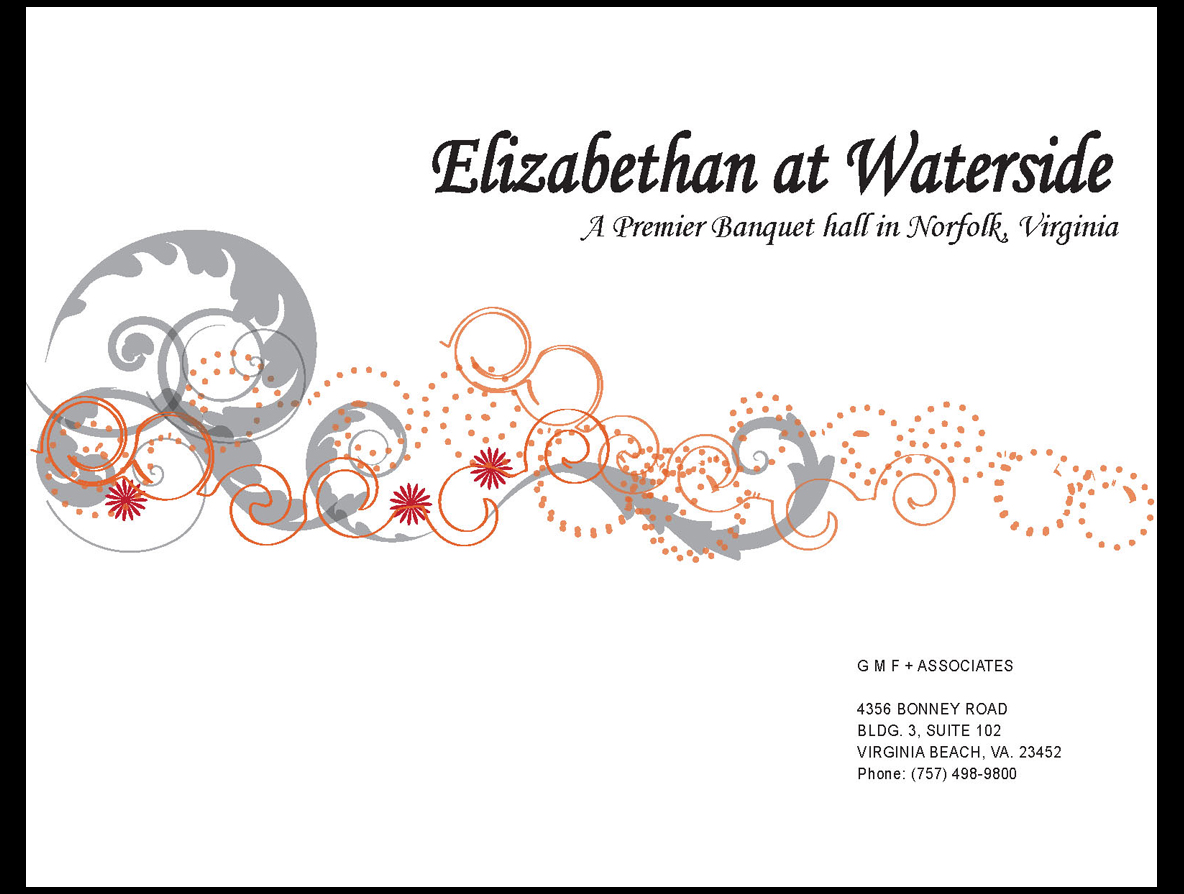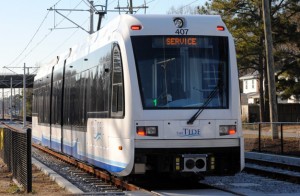You are currently browsing all posts tagged with 'The Tide'.
The alternative to extending Light Rail now is a Grim Tale
posted on Wednesday, November 13th, 2013 at 4:28 pmLight Rail “nay sayers” have a view of the future that our choice is between (1) more and wider roads, or (2) a fixed rail link between regional communities that is likely to run in the red for the near term.
Choice (1) is folly since building roads destroys the environment and fossil fuels will inevitably run out for our private cars to drive on them. More roads also spreads out the population settlement pattern that in turn requires even more roads, greater destruction of the environment, more pollution and further commuting congestion and community separation.
Choice (2) will run in the red until settlement patterns catch up with the regional vision of the future. Light rail is expensive and requires investment at the earliest opportunity for a sustainable future.
I was charmed with the photo of the front page of the Hampton Roads section of the Virginian Pilot this morning. Imagine, three private proposals for extending the TIDE light rail from Norfolk into Virginia Beach. What a bright future there could be in the future of Hampton Roads.
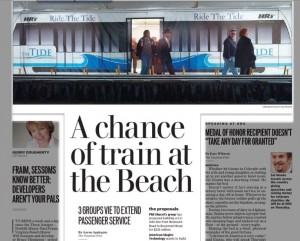
The reason that the smaller metropolitan area of Charlotte, NC already has light rail serving its commuter population could be because the political leadership there is operating with a vision of itself as a cohesive regional economy, rather than a balkanized satellite cities competing for a separate piece of action.
It seems to me there are regional transportation investments that could make a huge difference in the future growth of Hampton Roads towards becoming the regional economy that it deserves to be: (1) an expanded commuter Light Rail system, and (2) an expanded nationally focused airport with its own designated airline Hub.
Earlier this week Governor-Elect Terry McAuliffe included mention of his support for extending light rail to Virginia Beach: “One important issue that I did campaign on — it is time we took light rail all the way from our naval base all the way to Virginia Beach.”
It is worth a chuckle to see the photo of Kerry Dougherty, at the top of her column, overshadowed by the banner image of The TIDE rail car along with the headline: “A Chance of Train at the Beach.” As if to say, “Kerry, you missed the train,” with her non-supportive commentaries, completely misunderstanding the opportunity that light rail means for the region of Hampton Roads.
Tags: future, Hampton Roads, investment, Light Rail, region, The Tide, transportion, virginia beach
Light Rail and Wal-Mart are from different planets!
posted on Wednesday, June 19th, 2013 at 3:33 pmPlanning and academic research on the subject of property value changes due to the presence of a nearby Light Rail station consistently documents a positive investment opportunity, especially for commercial property and apartments.
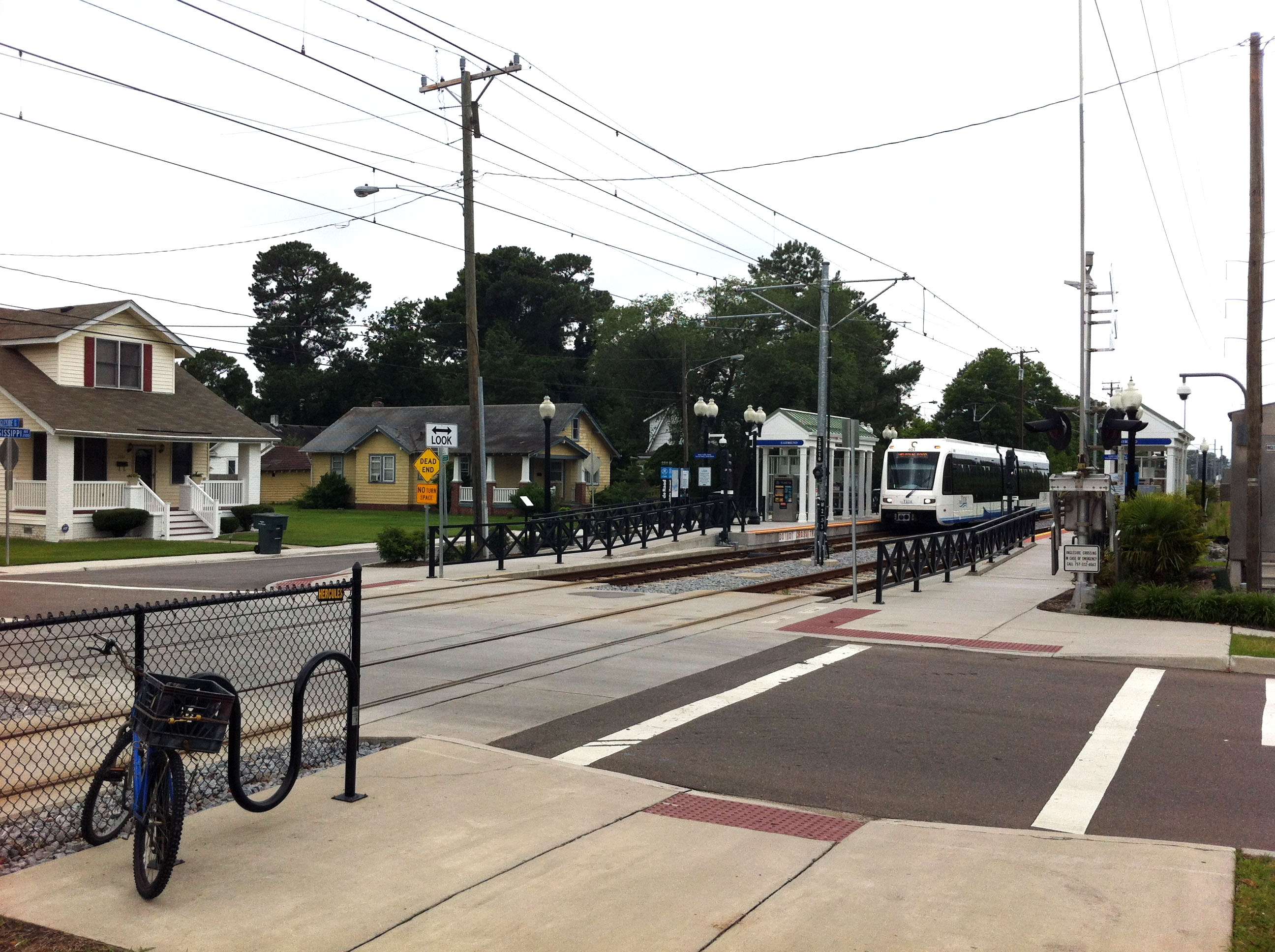
There was an article on the second page of the Virginia Pilot in the June 8th issue, relaying a story about a new Wal-Mart and Wawa coming to the intersection of Ingleside Road and Princess Anne Road in Norfolk. My first thought was, “Does this investment have anything to do with the proximity of the Ingleside Light Rail station for The Tide?”
The article compared the proposed Wal-Mart at Ingleside to a so-called “Neighborhood Market” on Holland Road in Virginia Beach. A typical Wal-Mart store does tend to look and operate like the Holland Road Marketplace. That project would be more aptly be described as an “Un-neighborly Marketplace” since walking there from a nearby house or apartment is to be faced with traversing a wasteland of parking areas and driving aisles. I am open to the possibility that Wal-Mart and Light Rail could be designed to be mutually supportive but the comparison to the Holland Road Marketplace translates to more of the same.
City planners can sometimes influence the design of a large commercial project. They cannot however, transform the design from a big box store to become a truly pedestrian-friendly “Neighborhood Market” project. This project is likely to look and function like the Holland Road Marketplace to which the article writer refers. (That site was formerly a giant Super K-Mart that was closed a few years back.)
The proposed Wal-Mart project is not likely to be a positive influence on the surrounding neighborhood at Ingleside and Princess Anne roads, in terms of becoming a better place to live. There is already another Wal-Mart center about 3 miles away, next to the JANAF shopping center, whereas the proposed new location is 1.7 miles from the Ingleside Light Rail station. Sadly, there is no pedestrian linkage between the two. Distance is not the only obstacle to overcome for Ingleside Road to be imagined as a walking path to the new Wal-Mart, since there is also Norfolk Industrial park that lies along the route.
I believe the presence of light rail is the single most direct opportunity to influence proper urban patterns into the future. As gasoline prices climb upward to the level that they are in Europe already ($12 per gallon) development choices are going to need to be made that do not depend on the private automobile to the extent that has been during the 20th century. We can begin now to make development choices that will shape our urban environments to function more like European cities. Pick your favorite European city and notice how important fixed route public transportation is to the pleasure of the place.

Weighing the pluses and minuses of this prospective Wal-Mart at Ingleside Road and Princess Anne Road, I can see that the new Wal-Mart is good for the tax base of the City of Norfolk, and would provide some new jobs in the area. Another plus is that this Wal-MartCenter has two HRT bus routes within a half mile radius.
By having these bus routes close to the Wal-Mart, they make this proposed site an infill property that is well integrated into the fabric of the existing public transportation systems. Even if the City Planners succeeded in helping the new Wal-Mart appear to be a pedestrian destination instead of another automobile oasis, it is not walkable to the surrounding residents.
I would like to see the stops for The Tide light rail surrounded by small retail establishments that can service the commuters. When stations provide parking spaces for commuters, retail businesses see advantages in locating to those areas. A treed park could pop into the picture, and pretty soon nearby residents would go to those areas for reasons other than to board the light rail. The criteria for selecting stops for new light rail routes should strongly take into consideration intersections where there is already some element of pedestrian activity. The Wal-Mart at Ingleside and Princess Anne Road will do nothing positive for its surrounding neighborhoods. Neither does it contribute to stimulate any pedestrian dynamics for the light rail station at Ingleside Road.
The presence of the Tide light rail station stop at Ingleside Road and the proposed Wal-Mart at Ingleside are too far apart to have a pedestrian relationship, too economically detached have common goals for the surrounding neighborhoods. It’s more like they come from different planets and chanced to land on the same road.
Tags: Hampton Roads Transit, Holland Road, HRT, Ingleside Road, Kroger Marketplace, Light Rail, new urbanism, Norfolk, pedestrian, public transportation, sustainability, The Tide, VA, Virginia, virginia beach, Wal-Mart, walkable
PROVIDE LIGHT RAIL TO PORTSMOUTH INSTEAD OF MIDTOWN TUNNEL
posted on Wednesday, July 18th, 2012 at 3:58 pmThe recent editorial in the Virginian Pilot is in favor of the campaign to squash plans for the construction of the Midtown Tunnel. Agreed. The extension of The TIDE Light Rail to Portsmouth is the better alternative. How fortuitous that the tunnel project could be declared unconstitutional. There are plenty of common sense reasons to scuttle spending $2.1 billion for a “cars only” tunnel and its endless tolls.
The affect of the tolls on the commuters of Portsmouth would severely upset the vision of regionalism in Hampton Roads. The toll would hurt business growth in Portsmouth. Neighbor-city residents will be discouraged from going to Portsmouth for shopping, sight seeing, restaurants, ntelos venues, museums, the list goes on. Imagine how the tolls will affect real estate values in Portsmouth?
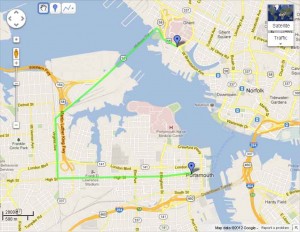 ATTENTION VDT! One way to reduce traffic on the existing midtown tunnel would be simply to introduce the tolls without the expansion. The capital cost will be zero where the effect the same. And what will happen to all the traffic during construction? Won’t it get severely worse? Is the expansion of the tunnel as a remedy for improving commuter time worse than the problem itself? The idea of the expanded tunnel is great for more cars but fraught with side effects: worse pollution, greater fossil fuel consumption, increased noise, additional storm water flooding.
ATTENTION VDT! One way to reduce traffic on the existing midtown tunnel would be simply to introduce the tolls without the expansion. The capital cost will be zero where the effect the same. And what will happen to all the traffic during construction? Won’t it get severely worse? Is the expansion of the tunnel as a remedy for improving commuter time worse than the problem itself? The idea of the expanded tunnel is great for more cars but fraught with side effects: worse pollution, greater fossil fuel consumption, increased noise, additional storm water flooding.
As an architect I am schooled in the notion of designing for a vision of the future in terms of lasting for at least a century. It is the “greenest” thing I can do to create a project that is not torn down and replaced before the mortgage is paid off. Site plans are cognizant of the 100-year flood plane as an important design criteria. Shouldn’t transportation systems be held up to the same time horizon? Isn’t fossil fuel depletion, pollution, and land economics setting a stage for an urban development pattern that favors people ahead of providing for ever greater numbers of cars?
 Could it be that in 100 years (maybe longer) the expansion of the Midtown Tunnel would look like a bridge to nowhere? There is better idea. Enter the TIDE, here to save the day, with a rolling cape, snappy logo and the ability to vanquish the most powerful villains. Super TIDE has arrived. Our posted map shows that the travel distance to downtown Portsmouth is less than six miles from EVMC (Eastern Virginia Medical Center), the current last stop of the exiting light rail (including the length of the tunnel itself).
Could it be that in 100 years (maybe longer) the expansion of the Midtown Tunnel would look like a bridge to nowhere? There is better idea. Enter the TIDE, here to save the day, with a rolling cape, snappy logo and the ability to vanquish the most powerful villains. Super TIDE has arrived. Our posted map shows that the travel distance to downtown Portsmouth is less than six miles from EVMC (Eastern Virginia Medical Center), the current last stop of the exiting light rail (including the length of the tunnel itself).
We already know that the cost of construction for a light rail tunnel is “considerably less” than the “cars only” tunnel expansion project as currently proposed. It is reasonable to imagine that the cost of providing a new train tunnel as well as extending The TIDE all the way to downtown Portsmouth may be no more expensive than the Midtown Tunnel project with none of the negative side effects.
Light rail promotes urban development patterns that have long term future benefits, providing the millennium planning view for Hampton Roads. Hamilton, Ontario, is an example of a city where citizens have taken a stand for their city’s potential in becoming a more vibrant, livable, and attractive place to live and work. Eight positive reasons in favor of light rail are listed on its website. The extension of the TIDE to Virginia Beach is great. Its time to call in Super TIDE to save the day in Portsmouth too.
Tags: Light Rail, Portsmouth, regional, The Tide, tolls, tunnel
Virginia Beach City Council voted in favor of a public referendum for Light Rail
posted on Tuesday, April 24th, 2012 at 6:13 pmThis is a big step forward since there was a previous referendum in 1999 that was voted down. I was among the testifiers at the council hearing vote the night of April 24, 2012. There were speakers for and against at the hearing. A primary theme of the nay sayers was that they wanted to delay the referendum until after a feasibility study was completed toward the end of 2012. Some of my remarks follow:
All the while I have pursued my livelihood as an architect I have continued to see myself as something of a city planning thinker. The principle of NEW URBANISM is what I stand for and why I speak for what I believe is the single most important regional opportunity for the future of New Urbanism in Hampton Roads, extending the Tide Light Rail into Virginia Beach.
The opportunity is about what and where to spend public funds for transportation improvements: ROADS ONLY or LIGHT RAIL as well as ROADS
As I see it – We could continue to spend tax revenue exclusively on improving roads and highways….
We could continue
extending highways and enlarging tunnels that inevitably become clogged with ever greater numbers of automobiles (contributing to air pollution, traffic accidents and lost time commuting)
We could continue
consuming vast amounts of vacant land for more and wider roads, thereby creating the need for further expenditures of tax monies to handle storm water runoff, landscape maintenance and noise separation barriers
We could continue
promoting low-density residential developments of architectural monotony, encouraging “look alike” subdivisions of single-family units separated by individual driveways with cars parked in front yards
We can continue
developing automobile oriented shopping centers surrounded by acres and acres of pavement that require a car to reach
I believe the public knows better than many transportation planning administrators and industry stockholders that would have us spend all our transportation tax monies on subsidizing the future dependence on the automobile. I believe it is folly to imagine a future that can sustain ever greater numbers of automobiles and the availability of an unlimited supply of fossil fuels to operate them.
I believe the citizens of Virginia Beach are anxious to vote for a chance to have a choice in future for Light Rail as an alternative to automobileland.
Tags: extension, Light Rail, public transportation, The Tide, transit, virginia beach
Light Rail extension into Virginia Beach, sooner, rather than later
posted on Sunday, February 5th, 2012 at 9:51 pmDoes a proper vision of the future form of Hampton Roads include light rail transit? The question is more controversial than I imagined, most recently triggered by the story in the Virginia Pilot that there could be a referendum in November for the extension of the Tide into Virginia Beach. As of this writing, there is posted nearly 300 reader comments in response to the article written one week ago. The article included some of the political “weighing in” of local elected officials.
My own attitude starts with the notion that the actions to be taken should be directed at maintaining and improving the region as a healthy place to live, recreate, earn a living, enjoying the beauty of the surroundings and preserving it for future generations. (Insert the name of your home place, there should be no disagreement.) Does that vision include light rail transit? I think it does. Here are some reasons that creating a referendum in November are timely opportunity to take:
1. The Tide has demonstrated a measure of success but it is incomplete until it is extended to include linking with a larger geographic area and the other cities of Hampton Roads. (The future of the automobile as the only mode of transportation for creating settlement patterns of the best urban places possible is changing.) The longer the extension of the Tide is put off the greater will be the delay in realizing the best vision of the future of this place, Hampton Roads.
2. There is a financial opportunity to make the extension to Virginia Beach in a not-too-distant future by virtue of the federal funding that is available. It is the best priority to follow, as a practical matter, since it will take decades for the full realization of the light rail network that is desirable in the “best future” vision.
3. A six-million dollar study is underway, purportedly to recommend the most practical form for the future of public transit in Hampton Roads. (There is no doubt that an increased interest in public transit in the future of this region is coming. That is a sure bet. What form it takes, buses or rapid transit or light rail, will shape the future development patterns for the better or worse.) Is it necessary to have a high-powered study completed to have an opinion on a vision of the future? Is the price tag really that much in doubt? Is the allocation of funds to create this transportation improvement that much different than making new roads or bridges to subsidize our dependence on the automobile?
4. Doing nothing, postponing or avoiding taking a stand on how to improve public transit into the best vision of the future for Hampton Roads, is irresponsible. Since a referendum would be necessary at the completion of the study that could delay the time it takes to get the light rail option started and jeopardize the availability of federal funds, not to mention the increased capital expenditures due to rising construction costs.
5. Critics of the extension project have cited the crime problems of the Baltimore Light Rail Station in Linthicum as an inherent objection to light rail. But that is an irrelevant distraction to the opportunities at hand with the extension of the Tide into Virginia Beach. Neighborhoods are not all the same. Presumably spending 6 million dollars on a study provides some insight into recommendations for station location, physical design and security considerations. Linthicum is not Bird Neck Road, that would be the last station on the extension corridor under consideration.
6. Lest it be forgotten, Virginia Beach already owns the existing Norfolk Southern right of way from Newtown Road to Bird Neck Road. That purchase was settled in September 2010. Council members voted unanimously to close the deal. It was a year earlier that the city purchased the former Circuit City property next to Town Center for a future location of a Light Rail Station. At that time the mayor promised a public referendum on the extension of the Tide, upon the conclusion of the transit feasibility study. Adjusting the timing of that referendum, in consideration of the funding sources available, is being a prudent consumer as opposed to a public manipulator.
I am excited about re-shaping neighborhood development patterns that would be driven by the introduction of light rail stations as a result of the extension of the Tide into Virginia Beach. (Extending rubber tire bus routes will not produce the same development opportunities for community place identification.) Yes, some real estate investors will make more than their share of opportunistic wind falls or more modest up ticks. If the vision of the future is for a Hampton Roads to be composed of urban community enclaves with denser development patterns, centralized, walkable, integrated communities and composed of buildings architecturally sustainable and diverse – I say, the sooner the better.
Tags: Hampton Roads, HRT, Light Rail, Neighborhood, referendum, retail development, stations, The Tide
2012 Shaping the future of Hampton Roads, Virginia
posted on Sunday, January 29th, 2012 at 8:46 pmThe Virginian Pilot this week has been chock-a-block with significant stories that could foretell some remarkable physical transformations of Hampton Roads for years to come. The visions of the future urban planning opportunities are all around.
1. HRT has established a bus route to Norfolk International Airport, 1/27/12 (how long have our airline travelers been deprived of this simple service?) It starts on February 5 and will be in effect only until March 10 to test customer interest. I think everyone should drive over to the airport and take a bus ride someplace to rack up some passenger data that will establish the service permanently. 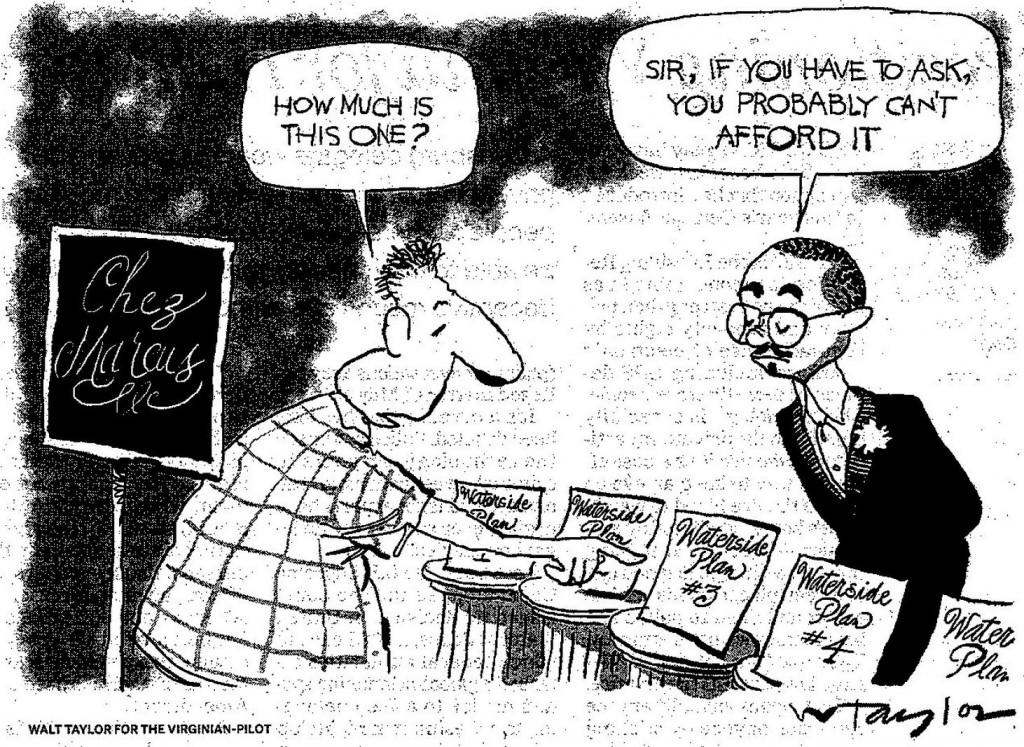
2. The editorial cartoon 1/29/12 for choosing a plan for the future of Waterside was worth a thousand words ….resounding the sentiments expressed by one of the Norfolk City council members at this week’s public display of the five plans under consideration: “Do we have to choose one of these?” Those of us in the audience of onlookers know the answer full well: “we want none of these plans if you please, they are all baloney.”
3. A really BIG item this week is the page one story 1/29/12 about a possible referendum in November for extending The Tide light rail into Virginia Beach. This is remarkable since it un-stalls the opportunity to get federal stimulus funds for the project before it’s too late.
4. Urban Outfitters is coming to 271 Granby Street. This news got a huge spread in the Sunday business section 1/22/12. It is actually is very good news, foretelling future prospects of re-establishing downtown Norfolk as retail shopping destination. Congratulations to developer Bobby Wright. This event brought out the editorial commentary of a staff writer, Michelle Washington, to emphasize the belief held by city and regional planners that this kind of development is the beginning of Norfolk’s reemergence as a pedestrian “happening” place, in her words: the city’s Cool Factor.
5. Then there was the story about the Kempsville Historic Master Plan, Beacon 1/29/12, where citizens are concerned about the crossroads acreage at Witchduck Road and Princess Anne. It is proposed to rezone the area to higher density residential use, namely apartments on the property surrounding the former Kemps Landing School structure. We hope that the fears of surrounding residents can be assuaged to allow for the opportunity to give this geographic confluence a sense of place that it lacks at the present time. Kempsville presently is hardly more than a zip code and a school district. Where is it really? How does someone know they are in Kempsville? The change of zoning will allow for a place-making opportunity that careful planning can shape into a desirable place to come, to walk, to mingle and to identify.
6. My last entry of the week’s recap of urban planning opportunities in the Virginian Pilot is kind of “tongue and cheek”, I admit. There was a story in the travel section about the Henry Ford Museum in Dearborn, Michigan. It struck me that cars belong in a museum and that maybe we will stop planning our cities and neighborhoods like life depends on the automobile. I visited Copenhagen this past year, where gasoline is the equivalent of $12 per gallon and the sales tax on purchasing a new car is 180%. In such an environment one learns quickly how to exist without depending on a car. The end result is walkable urban living patterns and some of the best shopping streets in the world.
Tags: Hampton Roads, HRT, Kempsville, planning, The Tide, urban, virginia beach, walkable, Waterside, zoning
Bold New Plan for Waterside – Front Page News
posted on Wednesday, January 18th, 2012 at 8:11 pmThe front page of the Virginian Pilot (1/17/2012) shows the first of five proposals for the resurrection of Norfolk Waterside. Titled BOLD PLAN FOR WATERSIDE, submitted by Harvey Lindsay Development, there is some inconsistent thinking in this particular Bold Plan for Waterside: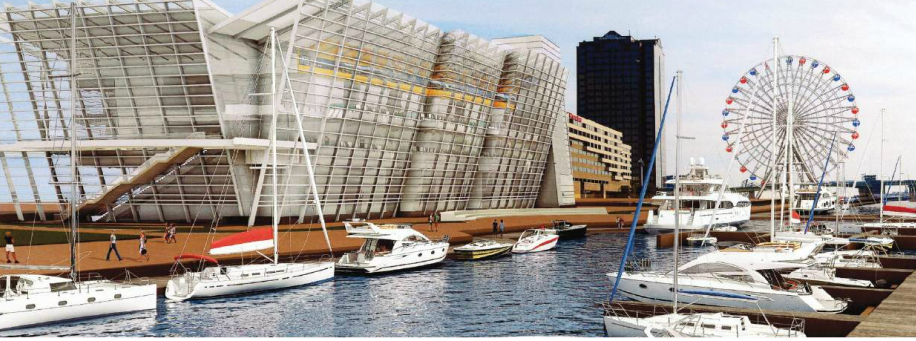
1. Waterside was not provided a stop on the Tide Light Rail. This represents a planning decision that it was not a priority for inclusion in the downtown circulation pattern for shopping or hotels. Rethinking that omission is paramount to any resurrection plan of Waterside. It is not addressed in the BOLD PLAN.
2. If the City of Norfolk craves a convention center Waterside could already serve that purpose with only modest alterations. The Harvey Lindsay convention center design concept proposes a 30,000 SF exhibition hall. The second floor of the East side of Waterside, formerly occupied by Julian’s, has potentially more than 60,000 SF of exhibition space available, without replacing the building. (There are other existing venues already available for attracting modest size convention business: Half Moon, Marriott, Sheridan, Nauticus, etc.)
3. What’s missing in downtown Norfolk is not more hotel rooms as proposed on Granby Street. What is needed is more residents who love to live in Norfolk, in apartment buildings. (Look at the wonderful waterfront urban development patterns in the most beautiful cities in Europe: Barcelona, Oslo, Frankfurt, Rotterdam, Stockholm, etc. Apartments are the predominant use, with good reason.) The movement toward new urbanism in the USA has many successful examples of street level shopping and pedestrian oriented street life with apartments above.
4. If Norfolk is inclined to saddle its citizens with a bill for $76,000,000, and more, to make a new Waterside what will it be foregoing by that choice. What about allocating subsidies to get Half Moon passenger terminal operating effectively? (It wasn’t long ago we were told that the passenger terminal had “pumped $100,000,000 in the local economy” 2001-2007.)
5. When the redevelopment plan for MacArthur Center was hatched it was a bad day for Waterside. The vision of Norfolk Waterside as a twin to Baltimore Inner Harbor was probably a stretch of the imagination. But it was such a compelling idea. The truth is that while Norfolk is a beautiful urban place that is getting better every year it will be generations before it can support the walkable retail environment that exists in Baltimore. (The density of residents in urban Norfolk cannot compare to Baltimore.)
6. I am convinced about the value of green building strategies as an important design consideration for all future construction. (There is a lot of “gizmo green” products and systems that are being marketed vigorously to publicize participation. That can be a distraction from meaningful green principles.) Green building starts with creating buildings that last, for many many generations. Waterside has some life left to go. It is barely 25 years old.
 I am looking forward to reading other proposals for the resurrection of Waterside. It is hard to see the Bold New Plan as a step in the right direction. I would like to post comments from my readers.
I am looking forward to reading other proposals for the resurrection of Waterside. It is hard to see the Bold New Plan as a step in the right direction. I would like to post comments from my readers.
Tags: adaptive reuse, apartments, density, The Tide, waterfront, Waterside
Waterside Interior Renovation
posted on Monday, October 24th, 2011 at 5:35 pmNorfolk, VA
Introducing the “Elizabethan at Waterside”, for the Elizabeth River of course. In 2010 GMF+ conducted an architectural and feasibility study for converting the former Julian’s Gaming Bar into a premier banquet facility. The study determined the available enclosure yields 33,000 SF of Dining space, with 9 separate or combined banquet rooms; 9,000 SF for the Kitchen and Restrooms; 2,500 SF for Lobby and Hallways; 1,000 SF for private offices. A copy of this study is available by calling our offices.
Tags: boardwalk, Elizabeth river, half moone, julians, management, marriott, nauticus, Norfolk, proposal, RFP, The Tide, town point park, Waterside
Plan a wedding along a river boardwalk, adjacent to a gorgeous urban park
posted on Saturday, October 22nd, 2011 at 7:07 pmIt is not a crazy notion to imagine Norfolk’s Waterside as a premier restaurant and banquet catering facility. While Waterside has been “the subject of endless studies, surveys and hand-wringing over the years” it continues to sit underutilized and marginally enjoyed, not to mention a financial albatross to the City of Norfolk.

Introducing the “Elizabethan at Waterside”, for the Elizabeth River of course: in 2010 GMF+ conducted an architectural and feasibility study for converting the second floor of the western 2/3 of the existing structure into a premier banquet facility. (This equates to the space formerly occupied by Julian’s Gaming Bar and Restaurant, some 55,000 SF.)
The study determined the available enclosure would yield 33,000 SF of Dining space, partitioned into 9 separate or combined banquet rooms. In addition there would be 9,000 SF for the Kitchen and Restrooms, 2,500 SF for Lobby and Hallways, and 1,000 SF for private offices. The banquet rooms are bordered on the Southern side by a 10-foot wide balcony overlooking the Elizabeth River. That balcony is totally accessible through the full height glass window walls of the new banquet rooms.
All 200 feet of the existing balconies would be private to the banquet facility, with two existing stairs leading to the boardwalk below. The boardwalk is over a mile in length, extending from the parking garage next to the Berkley Bridge, running along the Bank of Hampton Roads Dominion Tower, the Sheraton Waterside Hotel, Town Point Park and Half Moone Cruise Terminal and Nauticus Museum. The setting is spectacular. Less well-appointed waterfront banquet sites have enjoyed enormous success in Baltimore, Pensacola, and Long Island, NY.
 There are already convenient parking towers, across the street and others within walking distance of the facility, not to mention spacious two-way drop-off and valet curb facilities, even space for temporary parking. We determined there would need to be a private ground level entrance at the drop-off curb; a feature easily remodeled into the existing structure and illustrated in the GMF+ study. The setting lends itself to anything the wedding party can imagine, a water vessel entourage, floating barge dancing, outdoor musicians, sunset photos in Town Point Park, a horse-drawn carriage on the boardwalk, there is no limit.
There are already convenient parking towers, across the street and others within walking distance of the facility, not to mention spacious two-way drop-off and valet curb facilities, even space for temporary parking. We determined there would need to be a private ground level entrance at the drop-off curb; a feature easily remodeled into the existing structure and illustrated in the GMF+ study. The setting lends itself to anything the wedding party can imagine, a water vessel entourage, floating barge dancing, outdoor musicians, sunset photos in Town Point Park, a horse-drawn carriage on the boardwalk, there is no limit.
Last month City Manager Marcus Jones is reported to have declared that the 161,000 SF center should be turned over to the private sector. I agree. It could be that the management company that takes over is the anchor-operator of the banquet facility we see as such a logical primary use for the site. The economic development administrators in Norfolk should be looking for this kind of a management company. Tidewater Virginia is underserved by banquet choices for large gatherings. (The GMF+ study has data to demonstrate that fact.) The day is ready for the “Elizabethan at Waterside”.
Tags: boardwalk, Elizabeth river, half moone, julians, management, marriott, nauticus, Norfolk, proposal, RFP, The Tide, town point park, Waterside
Top Ten Reasons to celebrate the Tide
posted on Friday, September 2nd, 2011 at 8:05 pmI am kicking off my new blog on the inaugural week of the light rail in Norfolk, Virginia, an appropriate beginning to my “what say you” that is directed at urban planning issues especially as concerns designing houses and residential neighborhood communities, focused on the creation and preservation of what Steve Mouzon www.mouzon.com refers to as our “most loved places.”
Join in the excitement about Light Rail public transit in Hampton Roads, Virginia. Move over David Letterman, here are the top ten reasons to celebrate the Tide:
- 10. The cost of the Tide came in about the same as Light Rail in Houston that has a population 10 times as great, at about the same cost per mile. Hooray for tiny Norfolk!
- 9. The inaugural free ridership days (August 19-21, 2012) were extended for an additional a full week due to the popularity that was exhibited on opening day.
- 8. Even Norfolk natives are blown away by the visual connections that have transformed 7.4 miles of electric train into the golden strip urban of street life.
- 7. Economic incentives for businesses to locate near the light rail should increase the investment in residential neighborhoods, stimulate local-owner businesses and create pedestrian retail shopping communities.
- 6. Passengers can bring their bicycles on the Tide; there are wall brackets in the cars to hang one by folding back a pair of seats. Someday maybe there will be urban bikes in Norfolk.
- 5. It is a joy to ride the Tide to a baseball game at Harbor Park and avoid the parking lot mania before and after a game. Attendance is already jumped a notch since the Tide is running.
- 4. For a senior (over 60) going to a movie at Macarthur Center from Newtown Road will cost less for the ride than parking at MacArthur Center (not to mention saving the gasoline to drive there).
- 3. If jogging is your fancy, run around the beautiful Hague in Norfolk, park for free 7 miles away at Newtown Road station, enjoy an air conditioned recovery ride back to your car.
- 2. A great idea to visit downtown decorations at Christmas is to get a day pass on the Tide that also gives you a ticket for the Paddlewheel ferry from Waterside to High Street in Portsmouth and back. Enjoy the former Coleman Nursery Winter Wonderland in Olde Towne. Winter Wonderland in Olde Towne
- 1. Norfolk has pulled it off! Every year the extension of the Tide to Virginia Beach Resort strip is delayed will cost an additional $105,000,000 .…with an inflation rate on capital investment dollars for light rail transit tracking at 13 % annually. The extension estimate is currently reported at $807,000,000 (The Virginian-Pilot, April 9, 2011).
Tags: commuter, convenience, extension, Hampton Roads Transit, HRT, Light Rail, Norfolk, planning, Public Transit, The Tide, Town Center, traffic, transportation










